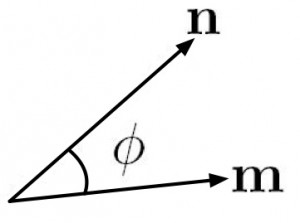The most obvious first step is to take the time derivative of the deformation gradient, ![]() , as follows:
, as follows:
![]()
For reasons that won’t become clear until the chapter on rate-form constitutive expressions, we would like the “velocity gradient” to be expressed with respect to ![]() rather than
rather than ![]() . Since
. Since ![]() is a function of
is a function of ![]() , we can use the chain rule to arrive at the following important expression:
, we can use the chain rule to arrive at the following important expression:
(1) 
We can see from eq. 1 that ![]()
or
![]() , where
, where ![]() is the “velocity gradient.”
is the “velocity gradient.”
For our purposes, consider that if we were to have analytical functions of time, ![]() , for each term in
, for each term in ![]() that describes how
that describes how ![]() and
and ![]() are changing with time, for example, then we could find
are changing with time, for example, then we could find ![]() by noting that
by noting that ![]() and
and ![]() . This is quite academic (and potentially quite difficult) compared to the way that
. This is quite academic (and potentially quite difficult) compared to the way that ![]() would be found in FEA, so such an example will not be given. However,
would be found in FEA, so such an example will not be given. However, ![]() is a very important quantity as we will see in the chapter on rate-form constitutive relationships.
is a very important quantity as we will see in the chapter on rate-form constitutive relationships.
The velocity gradient, ![]() , is a very important quantity and can be decomposed as follows:
, is a very important quantity and can be decomposed as follows:
(2) 
note: Similar to eq. 2, in linear infinitesimal elasticity, we can split the displacement gradient into a strain tensor and rotation tensor that are symmetric and anti-symmetric, respectively.
note: Any tensor can be similarly split into its symmetric and anti-symmetric parts.
“Rate of Deformation Tensor” = symmetric ![]()
“Spin Tensor” = anti-symmetric or “skew” ![]()
![]() is a pure rigid body rotation. A complete proof of this can be found in [Asaro]. It can also be easily shown that
is a pure rigid body rotation. A complete proof of this can be found in [Asaro]. It can also be easily shown that ![]() is, in fact, skew. This proof can be found in Appendix A.2.
is, in fact, skew. This proof can be found in Appendix A.2.
Consider the time rate of change of length of a particular element:
![]()
![]()
![]()
![]()
So, ![]()
(3) ![]()
While [Holzapfel] shows that “![]() is not pure rate of strain and
is not pure rate of strain and ![]() is not a pure rate of rotation,” we can see that the rate of change of length only depends on
is not a pure rate of rotation,” we can see that the rate of change of length only depends on ![]() , not
, not ![]() . Additionally, if
. Additionally, if ![]() then we must have rigid body motions only.
then we must have rigid body motions only.
note: We could have split up ![]() into a sum, but we wouldn’t have arrived at anything useful. The way that eq. 3 was derived only works due to the product rule of derivatives. Proving that
into a sum, but we wouldn’t have arrived at anything useful. The way that eq. 3 was derived only works due to the product rule of derivatives. Proving that ![]() represents “spin” is more difficult and won’t be shown here, although the derivation can be found in many other texts (e.x. [Asaro][Bonet][Holzapfel]).
represents “spin” is more difficult and won’t be shown here, although the derivation can be found in many other texts (e.x. [Asaro][Bonet][Holzapfel]).
Similar to the shear strain, ![]() , we can again consider how the angle between two vectors,
, we can again consider how the angle between two vectors, ![]() , and
, and ![]() , changes under deformation (see Fig below).
, changes under deformation (see Fig below).

(4) ![]()
note: ![]() (Recall also:
(Recall also: ![]() )
)
![]() reduces to
reduces to ![]() for infinitesimal deformation (ignoring rigid body rotations), since
for infinitesimal deformation (ignoring rigid body rotations), since ![]() .
.
In general, though, ![]() . Similarly, in general,
. Similarly, in general, ![]() . We’ll also look in detail at the physical meaning (or lack thereof) of
. We’ll also look in detail at the physical meaning (or lack thereof) of ![]() later on when we get to the chapter on “Rate-Form Constitutive Expressions”
later on when we get to the chapter on “Rate-Form Constitutive Expressions”
- R. J. Asaro and V. A. Lubarda, Mechanics of Solids and Materials, Cambridge, UK: Cambridge University Press, 2006.
[Bibtex]@BOOK{Asaro, Address = {Cambridge, UK}, Author = {Robert J. Asaro and Vlado A. Lubarda}, Edition = {}, Publisher = {Cambridge University Press}, Title = {Mechanics of Solids and Materials}, Year = {2006} } - G. Holzapfel, Nonlinear Solid Mechanics, John Wiley & Sons Ltd., England, 2000.
[Bibtex]@book{Holzapfel, title={Nonlinear Solid Mechanics}, author={Holzapfel, GA}, year={2000}, publisher={John Wiley \& Sons Ltd., England} } - J. Bonet and R. Wood, Nonlinear Continuum Mechanics for Finite Element Analysis. 1997, Cambridge University Press, Cambridge.
[Bibtex]@book{Bonet, title={Nonlinear {C}ontinuum {M}echanics for {F}inite {E}lement {A}nalysis. 1997}, author={Bonet, J and Wood, RD}, publisher={Cambridge University Press, Cambridge} }
